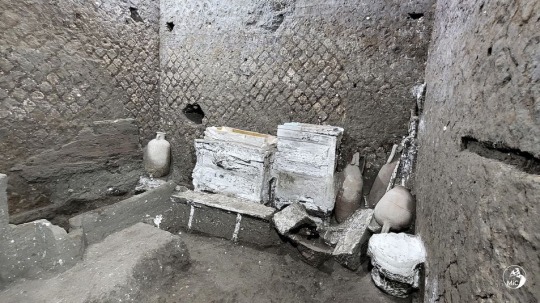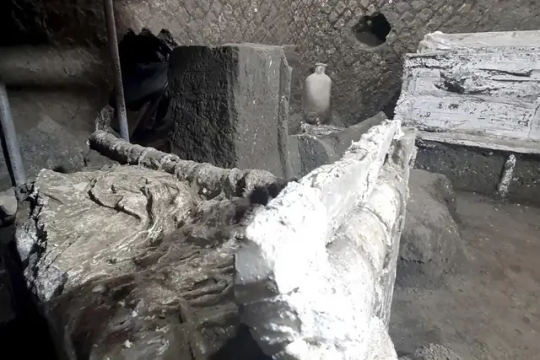#Archaeologists Uncover Slaves Room at Pompeii Villa
Text

Archaeologists Uncover Slaves Room at Pompeii Villa
Archaeologists have discovered a small bedroom in Civita Giuliana villa near Pompeii that was almost certainly used by slaves, throwing light on their lowly status in the ancient world, Italy’s Culture Ministry said on Sunday.
The room found at the Civita Giuliana villa contained two beds, only one of which had a mattress, two small cabinets, urns, and ceramic containers, in which the remains of two mice and a rat were found.
The room was found at the villa, some 600 meters (2,000 feet) north of the walls of Pompeii, which was wiped out by a volcanic eruption of Mount Vesuvius nearly 2,000 years ago.
“These details once again underline the conditions of precarity and poor hygiene in which the lower echelons of society lived during that time,” the culture ministry said in its statement.
Materials such as furniture and fabric decomposed over time after being covered by the devastating blast of rock fragments, gas, and ash from Vesuvius, leaving a void in the debris. When the plaster is used to fill the void, it reveals the original shape and contours of the long-gone material, including the outline of a crumpled blanket left on the bed netting.
No traces were found of grates, locks, or chains to restrain the room’s inhabitants.
“It seems that control was primarily exerted through the internal organization of servitude, rather than physical barriers and restraints,” said Gabriel Zuchtriegel, the director of the Archaeological Park of Pompeii.


The new room, called “room “A”, is different from the one already known as room “C”, rebuilt in November 2021 in which three cots were positioned and which served at the same time as a closet. What has now emerged suggests a precise hierarchy within the servitude.
While one of the two beds found in recent weeks is of the same invoice, extremely simple and without a mattress, as those of 2021, the other is of a more comfortable and expensive type, known in the bibliography as a “spalliera bed”. Traces of red decorations on two of the backs are still visible in the cinerite. In addition to the two beds, in the recently excavated room there are two small wardrobes, also partially preserved as casts, a series of amphorae and ceramic vases and various tools, including an iron hoe.

The micro-excavation of vases and amphorae from room “C” has in the meantime revealed the presence of at least three rodents: two mice in an amphora and a rat in a jug, positioned under one of the beds and from which it seems that the animal tried to escape when he died in the pyroclastic flow of the eruption. Details that once again underline the conditions of precariousness and hygienic discomfort in which the last of the society of the time lived.
Archaeologists said part of one of the beds had been destroyed by a tunnel used by robbers to access another part of the villa.
Excavations at the Civita Giuliana villa were carried out in 1907-1908, and then again from 2017, when police realized the site was being plundered by illegal diggers.



#Pompeii#Archaeologists Uncover Slaves Room at Pompeii Villa#Civita Giuliana villa#Mount Vesuvius#ancient artifacts#archeology#archeolgst#history#history news#ancient history#ancient culture#ancient civilizations#roman history#roman empire
32 notes
·
View notes
Text
Archaeologists have uncovered Roman slave quarters in a Pompeii villa, revealing a tale of deprivation and hardship 2,000 years ago.
19 notes
·
View notes
Text

Sorceress’ Kit; was discovered in the ashes of Pompeii. The box of small trinkets was likely used to perform fertility and love rituals and to look for omens about birth and pregnancy.
In the ancient Roman city of Pompeii, archaeologists digging in the Garden House recently uncovered the hinges of a wooden box, long since rotted away. But the contents of the box were still there, preserved in the ash that showered Pompeii in 79 AD, after nearby Mount Vesuvius erupted, creating an unprecedented time capsule of life 2000 years ago.
Treasure trove emerged from Regio V, an area of the city that has been under recent excavation. In total, archaeologists found around 100 little objects, including buttons made of bone, carved scarab beetles, miniature penises, crystals, tiny skulls and little dolls. It’s believed the objects may be part of a sorceress’ tool kit, used for fortune telling and to bring good luck, a press release from the Archaeological Park of Pompeii details.
Restorationists have cleaned up the objects and now historians and archaeologists are examining them to understand their meaning and significance.
“They are objects of everyday life in the female world and are extraordinary because they tell micro-stories, biographies of the inhabitants of the city who tried to escape the eruption,” says Massimo Osanna, director general of the archaeology park. Since there were no gold or precious objects in the trove, which wealthy citizens of Pompeii liked to flaunt, the cache of charms was likely not owned by the mistress of the house or a member of the family. Instead, Osanna tells Italian news agency ANSA that the owner of the sorceress’ kit was likely owned by a slave or servant. The objects could have been part of ritualistic jewelry used in ceremonies for things fertility, seduction, or to look for omens about a birth or pregnancy. One hypothesis? “They could have been necklaces that were worn during rituals rather being used to look elegant,” he says.
Whoever owned the box may still be in the house; archeologists have found the remains of several people in the luxury villa. “[W]e discovered a room with ten victims, including women and children, and now we are trying to establish kinship relationships, thanks to DNA analysis. Perhaps the precious box belonged to one of these victims,” Osanna suggests.
7 notes
·
View notes
Text
Italy: Archaeologists discover 'slave room' in Pompeii
Italy: Archaeologists discover ‘slave room’ in Pompeii
Archaeologists have unearthed the remains of a “slave room” in a Roman villa in Pompeii, officials said on Saturday.
He said the rare find in the ancient city, which was buried in ashes when Mount Vesuvius erupted in AD 79, appears to be in an excellent state of preservation.
Earlier this year, a fully intact ceremonial chariot was also uncovered at the site in southern Italy. Archaeologists…
View On WordPress
#Archaeologists Find Slave Room#current#harpianews#Indian Express#italy#Italy Slave Room#latest#news#Pompeii#Pompeii. in slave room#slave room#world#world news
0 notes
Link
Skeletal remains of what is believed to have been a rich man and his male slave attempting to escape death from the eruption of Mount Vesuvius nearly 2,000 years ago have been discovered in Pompeii, officials at the archaeological park in Italy said Saturday.
Parts of the skulls and bones of the two men were found during the excavation of the ruins from what was once an elegant villa with a panoramic view of the Mediterranean Sea on the outskirts of the ancient Roman city destroyed by the volcano eruption in 79 A.D. It’s the same area where a stable with the remains of three harnessed horses was excavated in 2017.
Pompeii officials said the men apparently escaped the initial fall of ash from Mount Vesuvius then succumbed to a powerful volcanic blast that took place the next morning. The later blast “apparently invaded the area from many points, surrounding and burying the victims in ash,” Pompeii officials said in a statement.
The remains of the two victims, lying next to each other on their backs, were found in a layer of grey ash at least two meters deep, they said.
As has been done when other remains have been discovered at the Pompeii site, archaeologists poured liquid chalk into the cavities, or void, left by the decaying bodies in the ash and pumice that rained down from the volcano near modern-day Naples and demolished the upper levels of the villa.
The technique, pioneered in the 1800s, gives the image not only of the shape and position of the victims in the throes of death but makes the remains “seem like statues,” said Massimo Osanna, an archaeologist who is director-general of the archaeological park operated under the jurisdiction of the Italian Culture Ministry.
Judging by cranial bones and teeth, one of the men was young, likely aged 18 to 25, with a spinal column with compressed discs. That finding led archaeologists to hypothesize that he was a young man who did manual labour, like that of a slave.
The other man had a robust bone structure, especially in his chest area, and died with his hands on his chest and his legs bent and spread apart. He was estimated to have been 30- to 40-years-old, Pompeii officials said. Fragments of white paint were found near the man’s face, probably remnants of a collapsed upper wall, the officials said.
Both skeletons were found in a side room along an underground corridor, or passageway, known in ancient Roman times as a cryptoporticus, which led to to the upper level of the villa.
“The victims were probably looking for shelter in the cryptoporticus, in this underground space, where they thought they were better protected,” said Osanna.
Instead, on the morning of 25 October 79 A.D., a “blazing cloud (of volcanic material) arrived in Pompeii and...killed anyone it encountered on its way,” Osanna said.
Based on the impression of fabric folds left in the ash layer, it appeared the younger man was wearing a short, pleated tunic, possibly of wool. The older victim, in addition to wearing a tunic, appeared to have had a mantle over his left shoulder.
Mount Vesuvius remains an active volcano. While excavations continue at the site near Naples, tourists are currently barred from the archaeological park under national anti-COVID-19 measures.
0 notes